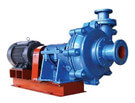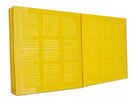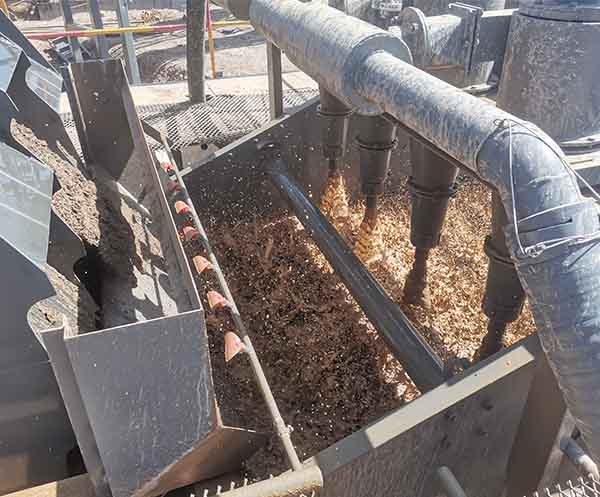Hot Product

- Hydrocyclone Group
Hydrocyclone group is widely used in coal preparation plant...

- Slurry Pump
Slurry pump is mainly used in mining, power plant, dredging, metallurgy...

- Polyurethane Dewatering Screen Panel
In addition to the performance of...
Factors Affecting The Classification Efficiency of Hydrocyclone Sand Separator
Date: 2021-05-19 From: Longding Author: admin
The main factors affecting the classification efficiency of the hydrocyclone are ore properties, structural and process operation in the production process. This article will popularize how various factors affect the efficiency of hydro cyclones, so as to help you use hydrocyclones correctly.
1. The unreasonable structure of cyclone separator
The structural factors that affect the working efficiency of the hydrocyclone mainly include the diameter and height of cylinder, the size of the feeding inlet, the diameter of the grit nozzle, the diameter and depth of the overflow pipe, and the size of the cone angle.
A. The diameter and height of the cylinder
The diameter of the cylinder determines the separation particle size and production capacity of the hydrocyclone. When the ratio of the feed pressure, feed port, overflow port, and the diameter of the cyclone remains unchanged, the production capacity of the cyclone will increase with the increase of the diameter of the hydrocyclone, and the separation particle size will also increase with the diameter of the hydrocyclone. The diameter increases and becomes thicker. Therefore, most concentrators select the hydrocyclone specifications according to the overflow granularity and even use multiple hydrocyclones in parallel.
The height of the cylinder mainly affects the length of time that the slurry is subjected to centrifugal force, which has a certain influence on the work efficiency. In general, the height of the hydrocyclone column is 0.6-1.0 times the diameter. The higher the height of the column, the finer the separation particle size, but if it exceeds a certain limit, it will lose its effect due to the increase in the pressure loss of the mine.
B. The size of feeding inlet
The size of the feed port will affect the working efficiency and production capacity of the hydrocyclone. If the feed size is coarser and the feed pressure is lower, the ratio of the feed port to the diameter of the hydrocyclone can be slightly larger, generally, 0.16-0.20 is appropriate. If the feed size is finer and the feed pressure is higher, the ratio of the feed port to the diameter of the hydrocyclone is usually maintained at 0.14-0.16. In addition, the shape of the feeding opening (usually rectangular) and the feeding method (tangent or involute) also have a certain impact on work efficiency.
C. Diameter of grit nozzle
Generally, the diameter of the grit nozzle is large, the overflow flow is small, and the overflow particle size becomes finer. While the amount of sedimentation increases, the concentration becomes lower, and the fine particles increase, but it has no obvious effect on the processing capacity. The diameter of the grit nozzle is small, the concentration of grit is high, and the discharge of grit is reduced. If it is too small, the coarse particles will accumulate more and more on the top of the cone, resulting in clogging. The proper diameter of the grit port should be such that the grit is discharged in an umbrella shape with an included angle of 40°-70°, and the ratio of the diameter of the grit port to the diameter of the overflow pipe is generally 0.4-0.8.
D. The diameter and depth of the overflow pipe
The diameter of the overflow pipe should be proportional to the diameter of the hydrocyclone. Increasing the diameter of the overflow pipe, the overflow flow will increase accordingly, the overflow particle size will become coarser, the fine particle size in the sedimentation will decrease, the sedimentation concentration will increase, and the classification efficiency will decrease. In addition, the ratio of the depth of the overflow pipe to the height of the hydrocyclone column should be maintained at 0.7-0.8. Too deep or too shallow will cause the overflow particle size to become coarser and the fine particle content in the sedimentation to increase, thereby affecting work efficiency.
E. The size of cone angle
The cone angle has an important influence on the working efficiency of the hydrocyclone. The cone angle becomes smaller, the distance between the overflow port and the grit sink is large, and the grading volume increases, which can strengthen the grading process of mineral particles in the hydrocyclone and facilitate the separation of fine-grained materials. When used for fine-grain desliming, the cone angle is generally 10°-15°. When used for coarse-grain classification, the cone angle is generally 20°-45°.
2. Ore properties
Ore properties mainly refer to the density, particle size composition, and slurry concentration of the ore. The higher the density of the ore, the finer the grading particle size. When the slurry concentration and the mud content is high, its viscosity and density increase, which increases the movement resistance of the particles and makes the classification particle size coarser, and vice versa. Therefore, when the sludge content is high, pre-desludging is required. The appropriate slurry concentration is usually determined by the beneficiation test according to the specific situation.
3. Process operation
The process operation factors that affect the working efficiency of the hydrocyclone mainly include ore feeding, overflow, and sand discharge. This requires operators to improve their skills during the production process, keep the operating parameters of each process within a reasonable range, and ensure the stable operation of the hydrocyclone.
Leave a Message
Here you can submit any questions and we will get back to you as soon as possible. We will not disclose the information you submit to anyone, please rest assured.



Inquiry